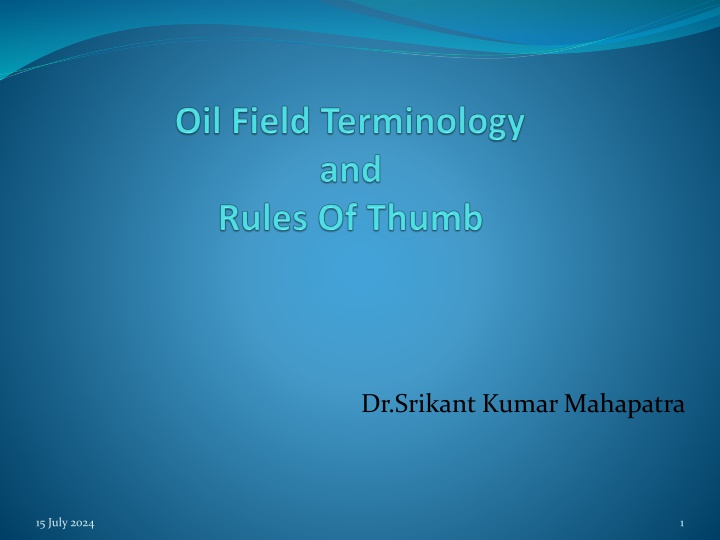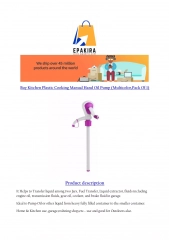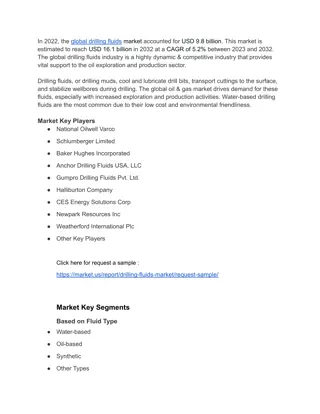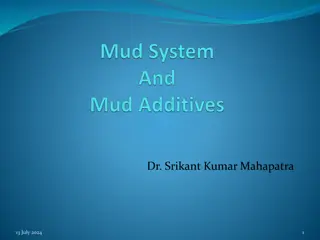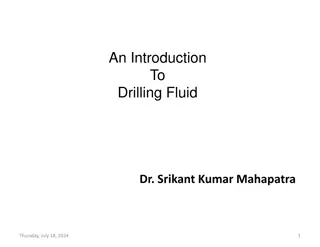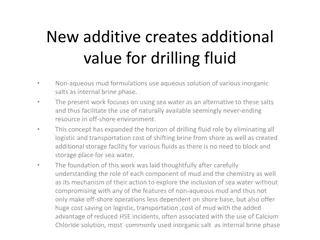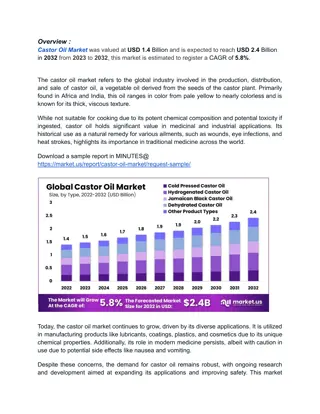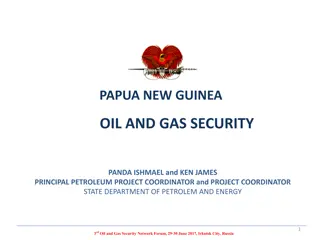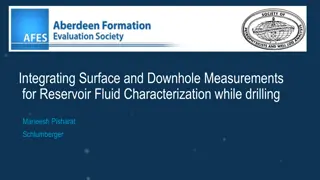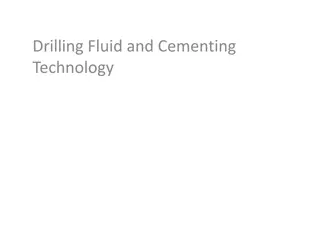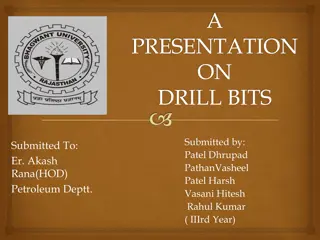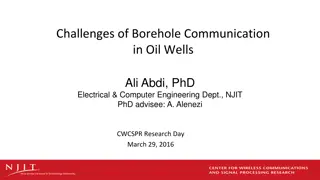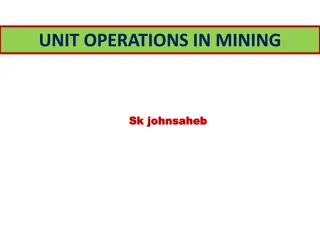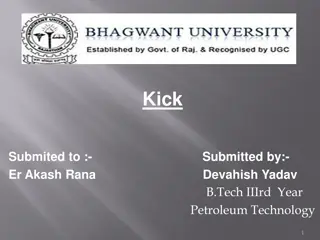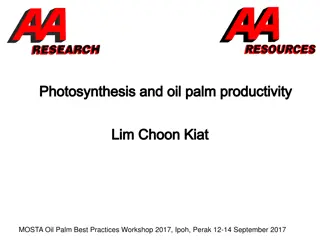Dr. Srikant Kumar Mahapatra - Oil Drilling Terminology and Operations Overview
Intelligent insights into oil drilling terminology and operations are provided alongside images and explanations related to processes such as abandonment, casing points, completion, and more. Dive into the world of drilling with a comprehensive guide enriched with visual aids.
Download Presentation

Please find below an Image/Link to download the presentation.
The content on the website is provided AS IS for your information and personal use only. It may not be sold, licensed, or shared on other websites without obtaining consent from the author.If you encounter any issues during the download, it is possible that the publisher has removed the file from their server.
You are allowed to download the files provided on this website for personal or commercial use, subject to the condition that they are used lawfully. All files are the property of their respective owners.
The content on the website is provided AS IS for your information and personal use only. It may not be sold, licensed, or shared on other websites without obtaining consent from the author.
E N D
Presentation Transcript
Dr.Srikant Kumar Mahapatra 15 July 2024 1
Abandon - A well is permanently plugged and abandoned if it is drilled and found to be a dry hole, or in the case of a producing well, it is not economically productive. Acidizing - A technique for increasing the flow of oil and/or gas into a well. Hydrochloric acid is pumped into the oil-bearing rock. The acid dissolves limestone in the producing zone enlarging pores and flow into the well bore with less restrictions. Annulus - The space between two concentric objects, such as between the wellbore and casing or between casing and tubing, where fluid can flow. Bit - A bit is the drilling tool that bores or cuts into the earth. There are two basic types: the cable tool bit which moves up and down the hole, striking the bottom, chipping away the rock, and the rotary bit which revolves to grind the rock. The rotary is the modern technique used in most drilling operations. Blowout - The uncontrolled flow of gas, oil or other fluids from a well. This happens when the down- hole pressure gas is not properly balanced by the weight of drilling mud. Blowout Preventer (BOP) - The equipment installed at the wellhead to control pressures in the annular space between the casing and drill pipe or tubing during drilling, completion, and workover operations. Also known as a Christmas tree. 15 July 2024 3
Casing Point - It refer to the depth to which casing is set in a well. Completion - A general term referring to all activities necessary to put a well on production after it has been drilled to casing point. The completion phase of operations generally includes cleaning out the well bore, setting the casing and tubing into the hole, adding surface equipment (pumps, tanks, meters) and perforating the casing so that oil or gas can flow into the well and be brought to surface. Once a well is completed, it is ready to produce oil or gas. Core - A cylindrical column of rock usually 4 to 6 inches in diameter cut in lengths of about 30 feet by a special drill bit (the operation is like removing the core from an apple). After the core has been brought to the surface, it is examined by geologist for shows of hydrocarbons. Cutting or Samples - Pieces of rock cut out of the formation by the bit and circulated to the surface by the mud. 15 July 2024 4
Daily Drilling Report - A record / report of the daily operations on a working drilling rig and, traditionally, phoned, faxed, emailed, or radioed in to the office of the drilling company and possibly the operator every morning. Degasser - The equipment used to remove unwanted gas from drilling fluid. Density - The mass or weight of a substance per unit volume. Specific gravity, relative density, and API gravity are units of density. Deposit - An accumulation of oil, gas or other minerals which is capable of production. Desander - A centrifugal device for removing sand from drilling fluid to prevent abrasion of the pumps. It may be operated mechanically or by a fast-moving stream of fluid inside a special cone-shaped vessel, in which case it is sometimes called a hydro-cyclone. Desilter - A centrifugal device, similar to a desander, used to remove very fine particles, or silt, from drilling fluid to lower the amount of solids in the fluid. Wildcat - An exploratory well drilled to a reservoir, from which no oil or gas has previously been produced in the nearby surrounding area. When the well is located far away from all previous drilling attempts, it might be called a 'rank wildcat'. Development Well - A well drilled to a known producing formation in an existing oil field. Discovery Well - An exploratory well which encounters production in a previously unknown deposit Exploratory Well - A hole drilled to find oil or gas in an area previously considered unproductive area or to extend the limit of a known oil or gas reservoir. 15 July 2024 5
Directional Drilling - Drilling in a direction away from the natural direction a wellbore would take. Displacement Fluid - In well cementing, the fluid, usually drilling mud or salt water, that is pumped into the well after the cement is pumped into it to force the cement out of the casing and into the annulus (the space between the casing and the outer wall of the well bore). Drawworks - The hoisting mechanism on a drilling rig. It is essentially a large winch that spools off or takes in the drilling line and thus lowers or raises the drill stem and bit. 15 July 2024 7
Drill Bit - The cutting or boring element used in drilling oil and gas wells. Most bits used in rotary drilling are roller-cone bits. Drill Collars - A heavy, thick-walled tube, usually steel, used between the drill pipe and the bit in the drill stem, used to stiffen the drilling assembly an put weight on the bit so that the bit can drill. Drill Floor - Also called rig floor or derrick floor. Drill Pipe - The heavy seamless tubing used to rotate the bit and circulate the drilling fluid. Joints of pipe are generally approximately 30 feet long are coupled together by means of tool joints. 15 July 2024 8
Dry Hole - Any exploratory or development well that does not find commercial quantities of hydrocarbons. Dual Completion - A single well that produces from two separate formations at the same time. Enhanced Oil Recovery (EOR) - Refers to a variety of secondary and tertiary recovery processes to increase the amount of oil removed from a reservoir, typically by injecting a liquid (e.g., water, surfactant) or gas (e.g., nitrogen, carbon dioxide). Doghouse - A small enclosure on the rig floor used as an office and/or as a storehouse for small objects. Dogleg - An abrupt change in direction in the wellbore. Downhole - Refers to equipment or mechanical operations that take place down a well bore. 15 July 2024 9
Fishing - The procedure of locating and retrieving an object (a 'fish') that has accidentally fallen into, or been left in the borehole, and must be retrieved before mechanical operations can be resumed. Flooding - One of the methods of enhanced oil recovery. The general method involves pumping (injecting) a fluid (commonly water) into the reservoir, through wells located around the perimeter of an oil field. Flowing Well - A well capable of producing oil or gas by its own energy without the aid of a mechanical pump. Downhole Motor - A drilling tool made up in the drill string directly above the bit. It causes the bit to turn while the drill string remains fixed. Two principal types of downhole motor are the positive-displacement motor and the downhole turbine motor. Downtime - Time lost during drilling, often as a result of equipment breakdown. 15 July 2024 10
Formation Damage - The reduction in permeability in reservoir rock due to the infiltration of drilling or treating fluids into the area adjacent to the wellbore. Injection Well - A well where gas or water is injected back into the reservoir, usually to increase pressure and thereby stimulate production. . Kelly Bushing (KB) - Part of the drilling rig, the Kelly is a long hollow steel bar that connects to the upper most end of the drill string. it is square or hexagonal in cross-section. The Kelly bushing is a 'sleeve' in the rotary table through which the Kelly can freely move up and down during drilling. 15 July 2024 11
MWD - Measurement While Drilling. Open Hole - Refers to a borehole, or the portion of a borehole, in which the casing has not been set. Packer - A flexible rubber sleeve that is part of a special section of pipe. When the drill string is lowered into the borehole, the packer can be expanded (from the surface), to temporarily block off a portion of the annulus of the borehole. Pay Zone or Pay - The section of rock, from which oil or gas is expected to be produced in commercial quantities. Drill Stem Test (DST) - A method of formation testing. The basic drill stem test tool consists of a packer or packers, valves or ports that may be opened and closed from the surface, and two or more pressure-recording devices. The tool is lowered on the drill string to the zone to be tested. The packer or packers are set to isolate the zone from the drilling fluid column. 15 July 2024 12
Perforate, means to create holes in the casing or liner of the wellbore through which oil and gas flows from the reservoir up to the surface. Perforation is accomplished with a perforating gun containing strategically placed explosive charges that is lowered into the wellbore. Perforating Gun - An instrument lowered by a wireline into a cased well. It contains explosive charges that are electronically detonated from the surface. The resulting holes allow hydrocarbons to flow from the pay zone into the borehole. Permeability - A measure of the ability of a rock to transmit fluid through pore spaces. Rocks may have holes or void spaces in them (porosity), but if these holes do not connect, the permeability can be drastically reduced. Plug - An object set in a borehole to block the passage of fluids (usually made of cast iron or cement). Plug Back - To block off the lower section of the borehole by setting a plug, usually to perform operations in the upper part of the hole. Plugged and Abandoned (P&A) - A depleted well or dry hole that has been (typically) filled with cement and marked, with all surface equipment removed. 15 July 2024 13
Re-Entry - Assume that a well has been abandoned, but subsequent drilling and production in the area suggests that a potential pay zone in the well was missed or 'passed over'. Instead of drilling a second well to evaluate the zone of interest, drill out the cement abandonment plugs in the original borehole to test the potential zone. Reservoir - Any rock having enough porosity and permeability to contain appreciable hydrocarbons. Most often reservoirs are sandstone and limestone (limestone/dolomite). 15 July 2024 14
Secondary Recovery - A broad term encompassing any method of extracting oil from a reservoir after a well or field has exhausted its primary production. Typical operation may involve forcing gas ('gas injection'), or water ('water flooding') into the reservoir. This re- pressurizes the reservoir, which allows recovery of more oil than would be possible from primary recovery. Shut In - To close valves on a well so that it stops production, or a well on which the valves have been closed. Drill String - The column, or string, of drill pipe with attached tool joints that transmits fluid and rotational power from the kelly bushing to the drill collars and the bit. Often, the term is loosely applied to include both drill pipe and drill collars. Drilling Break - A sudden increase in the rate of drilling. Usually it indicates that the drill bit is penetrating a porous layer of strata and/or can indicate crossing a fault. 15 July 2024 15
Spud - To spud a well means to begin the initial drilling operations. Squeeze - forcing cement into a wellbore to isolate perforations or repair damage. Stimulation - The term used for several processes to enlarge old channels, or create new ones, in the producing formation of a well designed to enhance production. Examples include acidizing and fracturing. Under Balanced Drilling - Drilling under conditions where the pressure being exerted inside the wellbore (from the drilling fluids) is less than the pressure of the oil or gas in the formation. 15 July 2024 16
Water Drive - The most efficient driving mechanism to force oil and gas out of a reservoir. Toward the end of the life of a water drive well, the fluid that is produced, contains increased percentages of water . Water Flooding - A secondary recovery method for the production of oil from a formation. When water is injected into some formations, the oil will float or be washed to the surface, thereby, increasing the amount of production from a well or field. Wellhead - The equipment at the surface of a well used to control the pressure; the point at which the hydrocarbons and water exit the ground. Whipstock - A steel blocking device placed in the bottom of a borehole. When drilling is resumed, the whipstock forces the drill bit to veer off at a slight angle. The deviated portion of the borehole is called a side track. Workover - Operations on a producing well to restore or increase production. A workover may be performed to stimulate the well, remove sand or wax from the wellbore, to mechanically repair the well, or for other reasons. Workover Rig - The rig used when oilfield workers try to restore or increase a well's production. 15 July 2024 17
PV = 3 to 3.5 times Mud Wt. YP = Mud Wt. (Not always) Vis = 4 x Mud Wt Above 12 ppg, % Solids = 2x Mud Wt. Add 1 to 2 sx of Bentonite for each hour centrifuge is run. sp. gr. x 8.33 = ppg bbl x 5.615 = cubic feet cubic feet x 7.48 = gallon Centigrade = (Fahrenheit -30)/2 Fahrenheit = (Centigrade x 2) + 30 15 July 2024 18
ECD in ppg : Multiply the YP by 0.1 and divide the hydaulic diameter in inch( hole dia pipe dia) into the number. Add this number to MW to get ECD. Example : MW = 12 ppg YP = 15 Hole Dia = 8.5 inch Pipe Dia = 5 inch 15 x 0.1 /(8.5-5) = 1.5/3.5 = 0.42 ECD = 12 + 0.42 = 12.42 ppg 15 July 2024 19
Pressure loss in the annulus : Multiply depth by YP and divide by the product of 225 times the hydraulic diameter (Hole dia-pipe dia) Example : Depth -5000 ft YP 15 Hole dia 8.5 inch Pipe dia 5 inch 5000 x 15/(8.5-5)x225 = 75000/675 = 111 psi 15 July 2024 20
Annular Volume in open hole : Square the hole size(inch) and subtract the square of the pipe size(inch). Divide by 1000 and multuply by length of hole section (feet) Example : Hole size -8.5 inch Pipe size 5 inch Hole section 6000 ft (8.5 x 8.5) (5 x 5)/1000 = 47.25/1000 = 0.04725 x 6000 = 283.5 bbl 15 July 2024 21
Capacity of pipe : Square the ID of the pipe (inch) and multiply by 0.097 to get bbl/ft. Capacity of annulus : Square of ID(inch) of outer string and substarct the square of OD(inch) of inner string. Multiply by 0.097 for bbl/ft. Weight of drill collar in lb/ft : Weight lb/ft = (Square of OD in inch square of ID in inch) 2.66 15 July 2024 22
